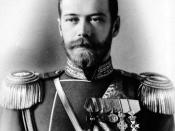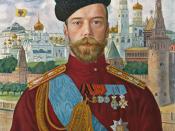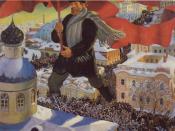The year 1917 saw Russia partake in two revolutions; each played a significantly important role in the progression of world history. The first revolution in February overthrew the monarchy. It was commonly known as the 'February Revolution'. The February Revolution involved a series of uprisings by workers and peasants throughout the country and by soldiers, who were predominantly of peasant origin, in the Russian army. Councils known as 'Soviets' led many of the uprisings; ultimately, they led to Tsar Nicholas II's downfall and the setting up of a 'Provisional Government' (who were basically the old Duma). The second revolution of 1917 took place in October. It was known as the 'Bolshevik Revolution' and it created the world's first communist state. The goal of those who carried out the second revolution was the creation of social equality and economic democracy in Russia.
The February Revolution was due to various long-term causes of the Tsars rule.
In 1904 the Tsar, in an attempt to regain the loyalty of his people and to show the might of his country, waged war on Japan. Unfortunately the war did not have the outcome the Tsar expected. Russia lost. Russia's defeat by Japan caused the army and the people of the country humiliation and made them discontent with Tsar Nicholas' rule. The peasants, urban workers, and middle class were sections of society Nicholas II struggled to deal with appropriately. The peasants remained poor and hungry for land, urban workers were alienated and dissatisfied, and the middle class were doing well and wanted to be more involved in local and national government, but were not allowed to take part in it. The country was industrializing fast. The Tsar failed to acknowledge this proving that the autocratic nature of his regime...


